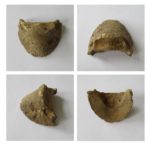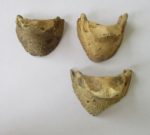 A three-week excavation on the site of the Roman circus in Colchester, southeast England, has unearthed the remains of one of the circus’ passageways and the hoof bone of a small horse. The Colchester circus was built in the 2nd century A.D. as a venue for chariot racing. It is the only Roman circus ever discovered in the UK and it’s the only one ever found north of the Alps. Its characteristic U-shaped arena was 450 meters (1476 feet) long had eight starting gates plus a monumental archway at the flat end of the U. There were three tiers of bleachers around the arena with one large entrance passage at the curved end and multiple other passageways through which the estimated 8,000 spectactors attending the races could enter and leave the stands. These entrances/exits were known as vomitoria in Latin because of the crowds that spewed forth from them. Some were also used by the staff for the quick removal of mangled bodies, human and equine, and chariots from the arena floor.
A three-week excavation on the site of the Roman circus in Colchester, southeast England, has unearthed the remains of one of the circus’ passageways and the hoof bone of a small horse. The Colchester circus was built in the 2nd century A.D. as a venue for chariot racing. It is the only Roman circus ever discovered in the UK and it’s the only one ever found north of the Alps. Its characteristic U-shaped arena was 450 meters (1476 feet) long had eight starting gates plus a monumental archway at the flat end of the U. There were three tiers of bleachers around the arena with one large entrance passage at the curved end and multiple other passageways through which the estimated 8,000 spectactors attending the races could enter and leave the stands. These entrances/exits were known as vomitoria in Latin because of the crowds that spewed forth from them. Some were also used by the staff for the quick removal of mangled bodies, human and equine, and chariots from the arena floor.
The Colchester Archaeological Trust (CAT), which raised funds to save the circus from being buried under a housing development and then even more funds to buy the adjacent Victorian barracks to expand the excavation and build a new visitor’s center, has been excavating the site for more than a decade and still don’t know precisely how many passageways the circus had. They estimate there were 12 of them. The newly discovered vomitorium is only the fifth unearthed so far and it is the best preserved of the five. Six Roman feet (5.8 feet) wide, it has a north-south orientation and led from outside the arena to the southern stands. Archaeologists thought the passageway in this section was about 20 feet east of the one they found, so the discovery came as a surprise.
 Another happy surprise was a small but significant find: a small hoof bone. Just 6 cm (2.4 inches) wide, 3.5 cm (1.4 inches) high and 4.2 cm (1.7 inches) deep, it’s the coffin bone, aka the distal phalanx, the core of the hoof. Its diminutive size — comparable to a large Shetland pony’s — suggests it came from a small female horse or a pony. The clean symmetrical shape and lack of wear indicates this was a young horse, but there is evidence of arthritis which would not be present in a young horse unless it was subjected to major physical strain. The sharp turns and hard running of the chariot races — each race required competitors to do 14 turns around the central spina and breakneck speed — would certainly qualify.
Another happy surprise was a small but significant find: a small hoof bone. Just 6 cm (2.4 inches) wide, 3.5 cm (1.4 inches) high and 4.2 cm (1.7 inches) deep, it’s the coffin bone, aka the distal phalanx, the core of the hoof. Its diminutive size — comparable to a large Shetland pony’s — suggests it came from a small female horse or a pony. The clean symmetrical shape and lack of wear indicates this was a young horse, but there is evidence of arthritis which would not be present in a young horse unless it was subjected to major physical strain. The sharp turns and hard running of the chariot races — each race required competitors to do 14 turns around the central spina and breakneck speed — would certainly qualify.
The bone was found inside the passageway. If this particular passageway was used for the removal of charioteers, horses and equipment that met a Ben Hur-like end in the arena, the little hoof could be all that remains of one of the equine athletes.
Mr Crummy said: “It is another exciting find but quite ambiguous as to what it means.
“There has been a long-running debate about the size of the horses which would have been used to race the chariots and this discovery suggests they would have been quite small.
“It suggests it would have been about nine hands quite is small but the bone has not been looked at properly yet.”
 Even if the horse wasn’t part of a chariot team, the bone is a significant find because horse remains are very rarerly discovered on the site of a Roman circus. Other ancient hoof bones have been found in Colchester, but not in the circus itself. They were also larger.
Even if the horse wasn’t part of a chariot team, the bone is a significant find because horse remains are very rarerly discovered on the site of a Roman circus. Other ancient hoof bones have been found in Colchester, but not in the circus itself. They were also larger.
You can explore the newly discovered circus entrance in this 3D model: